
Jura Route. Cycling adventure in western Switzerland
Jura - the Switzerland I never expected. That’s how I would sum up our 300-kilometer cycling journey through the Swiss Jura, probably the country’s most underrated region. The Jura Route, one of Switzerland’s nine national cycling routes, led us along gentle hills of the mountain range that marks the country's western border. Marked with red signs bearing the number 7, the route starts in Nyon, a lovely town on the shores of stunning Lake Geneva, which we had reached earlier via the Alpine Lakes Route. The Jura Route finishes in Basel, the same city where, two years ago, we wrapped up our adventure along the Rhine Cycle Route.
Route on the map
GPX file (GPS track): cyclingthread.com-jura-2022.gpx
Cycling Jura - table of contents
- Jura - so different from the Swiss Alps
- Mountains like a chapter of Earth's history
- Jura Route - one of Switzerland’s main cycling routes
- Quiet Jura divided by stone walls
- Two hundred and fifty million Jurassic ants
- Jura, the cradle of Swiss watchmaking traditions
- Not-so-safe Jura gravel roads
- Potato rösti at a Swiss farmhouse stay
- The homeland of Swiss absinthe - the “green fairy”
- Or maybe ham cooked in hot asphalt?
- Jura in Switzerland, unlike the Jura in Germany
- With Extrawheel panniers across Europe
- Art Nouveau, watches, and Islam in La Chaux-de-Fonds
- Across the Franches-Montagnes plateau to Saint-Ursanne
- In the heart of Switzerland's separatist canton of Jura
- On the route of the Grand Tour of Switzerland
- The final forty kilometers to Basel
- Who is the Jura Route for?
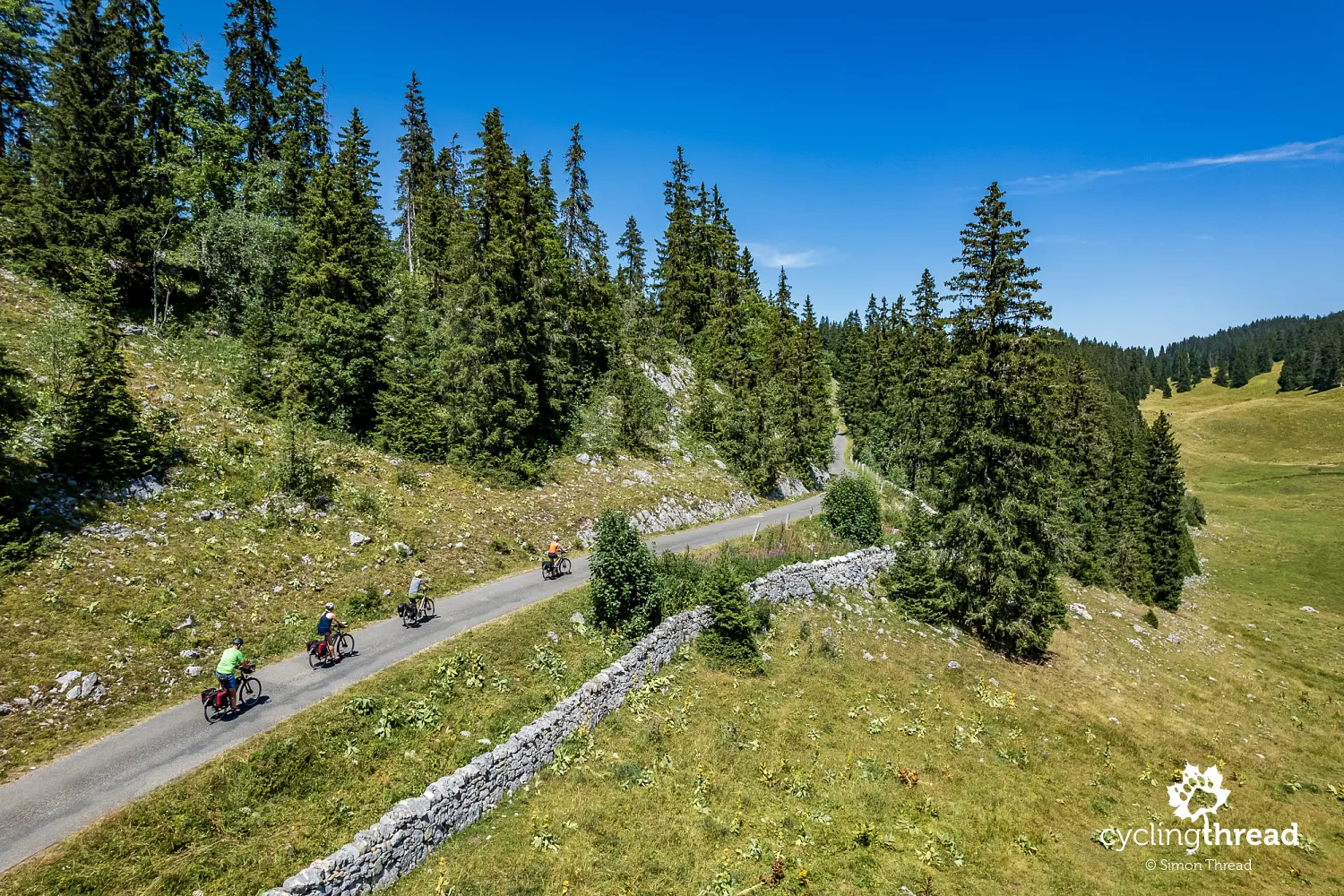
Jura - so different from the Swiss Alps
Even though we had read guidebooks - which speak rather sparingly about the Swiss Jura - and browsed a few online travel stories from the region, we were not prepared for what we actually saw. After covering long stretches of the Jura Route through remote mountain landscapes and cycling for many kilometers far from any towns or villages, often across sparsely populated farmland, we were left with an impression of a region that feels wonderfully wild, natural, and a bit secluded. It’s a huge contrast to the Alpine atmosphere that had filled our days along the Lakes Route just before. Even Switzerland’s official cycling website advises riders to stock up on plenty of water before setting off on some sections of the Jura, as there may be no villages or water sources for many kilometers - also because the rocky, limestone ground typical of Jura makes it hard for water streams to exist. Yet, this peaceful, secluded image I’m painting of Jura is not meant to discourage anyone - quite the opposite. If you are searching for tranquility and a real escape in Switzerland, Jura is the place to find it.
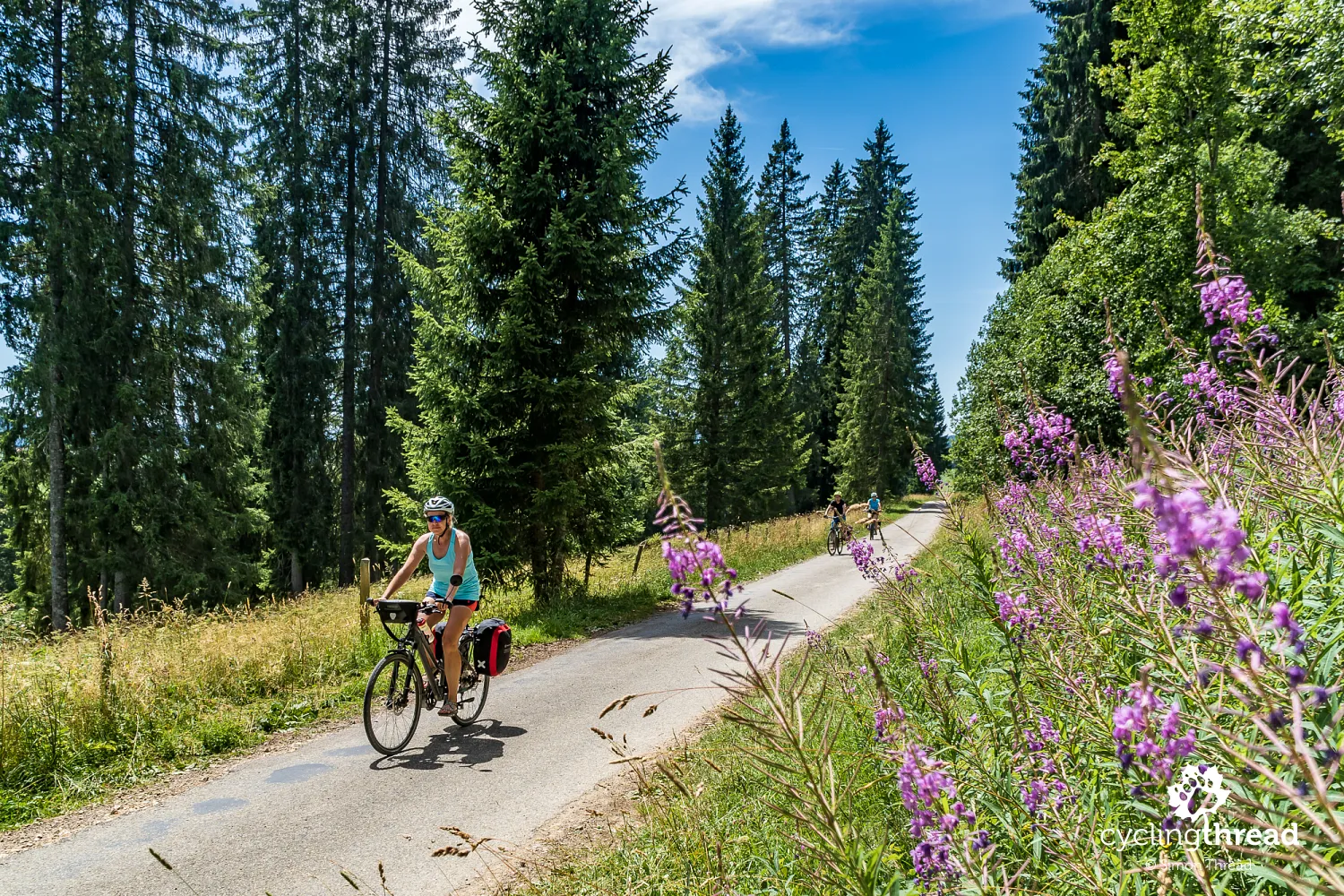
In today’s Europe, it’s getting harder to find such quiet, idyllic places where you can truly enjoy a cycling holiday. But that’s exactly what cycling days in Jura are like, as the dark red cycling signs led us into yet another silent mountain corner, where the only thing we could count on was the presence of grazing cows. These white, beige, brown, and black cows are a constant sight - often even blocking the path, looking just as surprised to see us as we were to see them standing right across the route. These gentle animals are cherished in Switzerland to such an extent that every spring and autumn (usually in June and September), they are paraded to and from pastures, adorned with colorful, flowery wreaths. Along the Jura cycling routes, you’ll easily find signs reminding visitors to respect grazing cows and especially cow mothers with calves. It’s almost impossible now to imagine Switzerland without cows and all the dairy delicacies they give us.
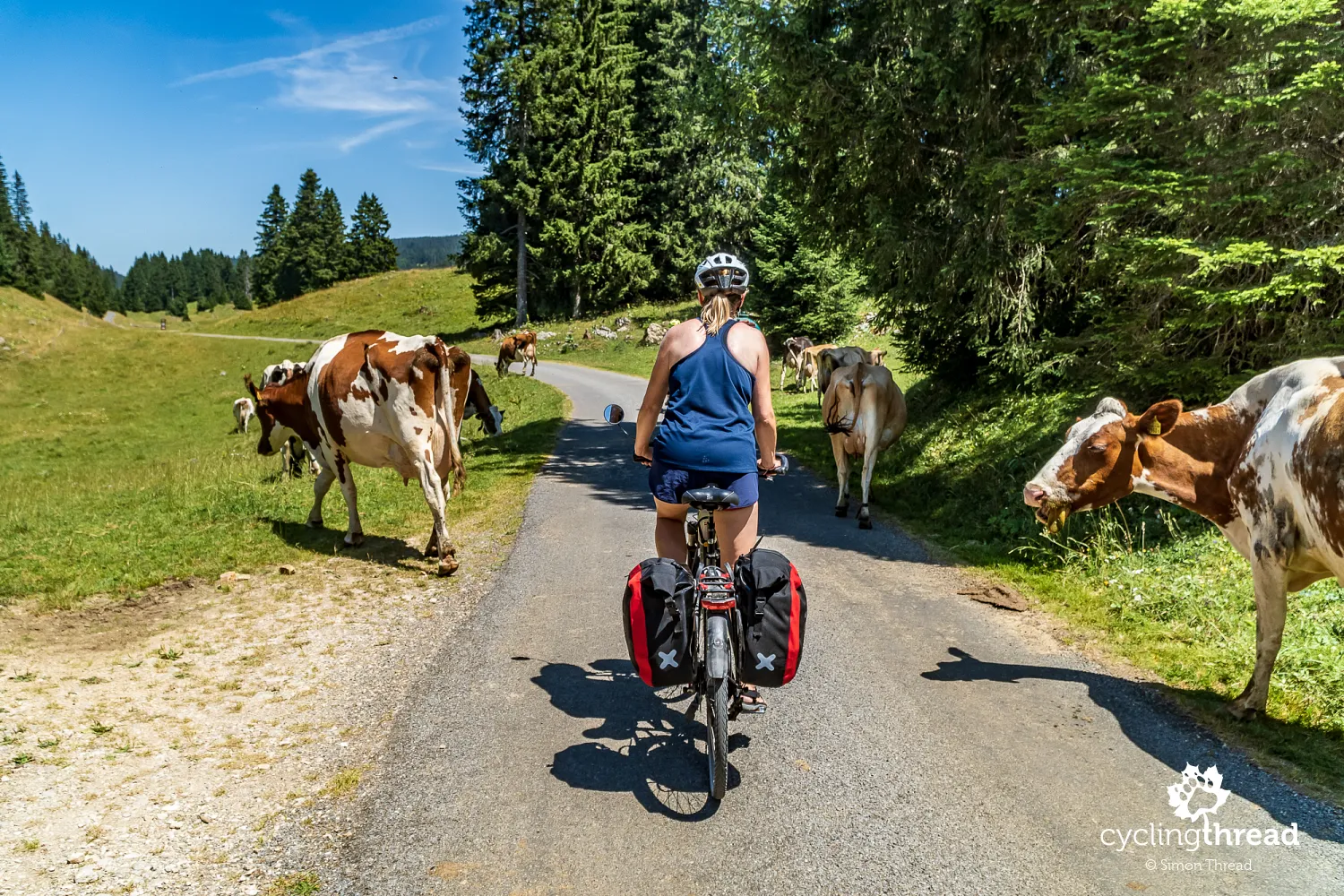
Mountains like a chapter of Earth's history
Most travelers will probably associate the name "Jura" with the Jurassic period - one of the three major divisions of the Mesozoic Era, along with the Triassic and Cretaceous. And maybe, like I once thought, you assumed that the Swiss mountains were named after that time period. But in fact, it was the other way around. The Jura Mountains were first named by the Celts or Romans, referring to them as "forest in the mountains." Centuries later, in the 18th century, German naturalist and geographer Alexander von Humboldt used the term "Jurassic limestone" to describe the rocks he found in Jura. French geologist Alexandre Brongniart then adopted this name, sealing it forever in science as the name of the period during which those rocks were formed. So, when cycling through Jura, it’s worth remembering that this landscape holds a special place in Earth’s scientific history - especially when passing the stunning rock layers exposed during the carving of the road on the climb from Travers. Just imagine: it took hundreds of thousands, if not millions of years, for each of these horizontal layers of limestone to form.
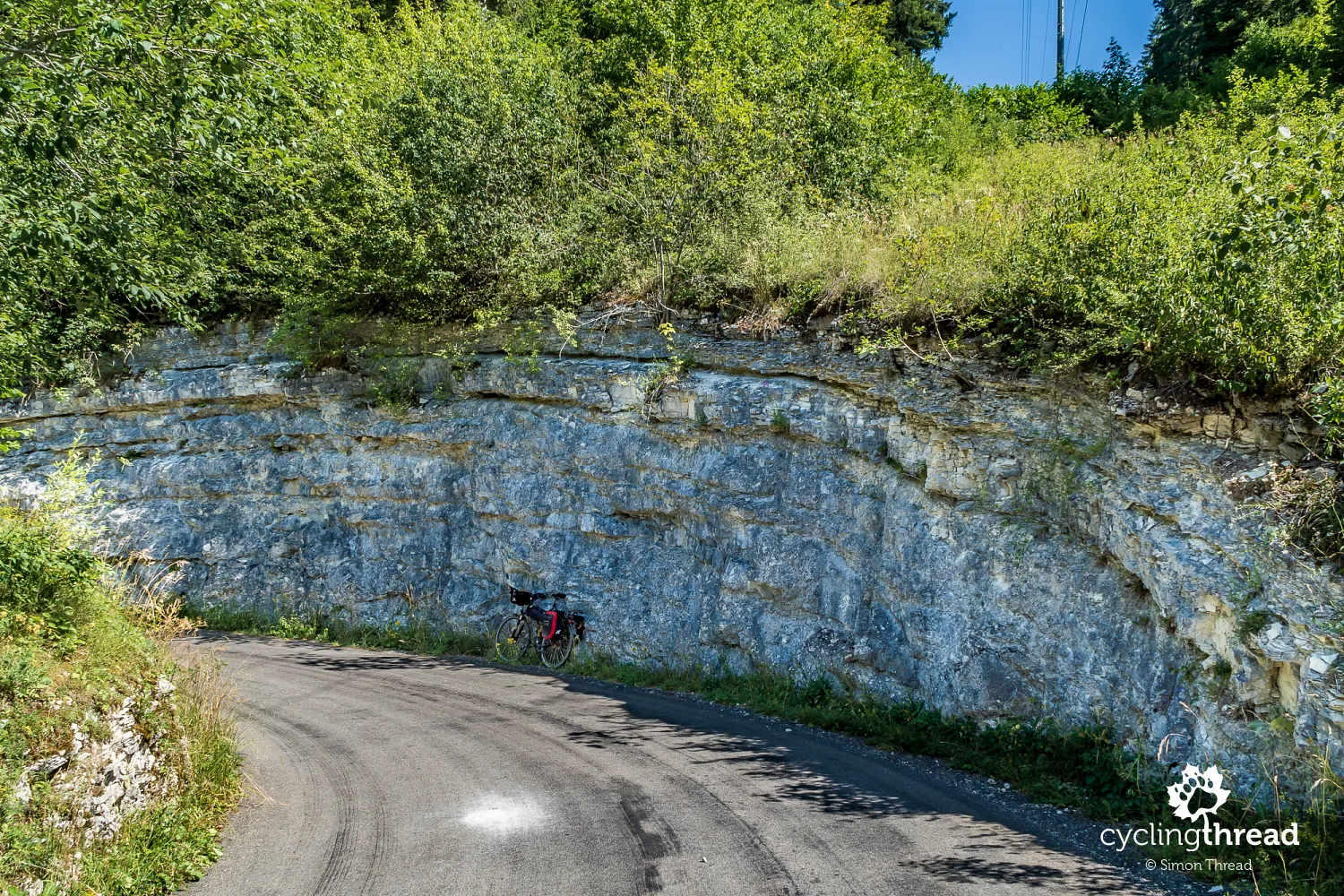
Jura Route - one of Switzerland’s main cycling routes
Our guide along Jura was the Jura Route - one of Switzerland’s main national cycling routes, whose information boards and maps regularly appeared along the way. The official length of the Jura Route is 266 kilometers, although our odometers counted nearly 300, including all the detours to accommodation, attractions, and the city of La Chaux-de-Fonds, which lies a bit off the main route. The difficulty level of the route is marked as "schwer" - hard - in the Schweiz Mobil system, and... it’s definitely worth taking that seriously. Unfortunately, I underestimated how demanding this route would be, which meant that our four days of riding sometimes felt a bit too intense for a holiday cycling trip. The total elevation gain, listed on the official Jura Route website, speaks for itself: over 5,400 meters of climbing across the route, which meant that with our four-day plan, we faced well over a kilometer of vertical ascent on average each day.
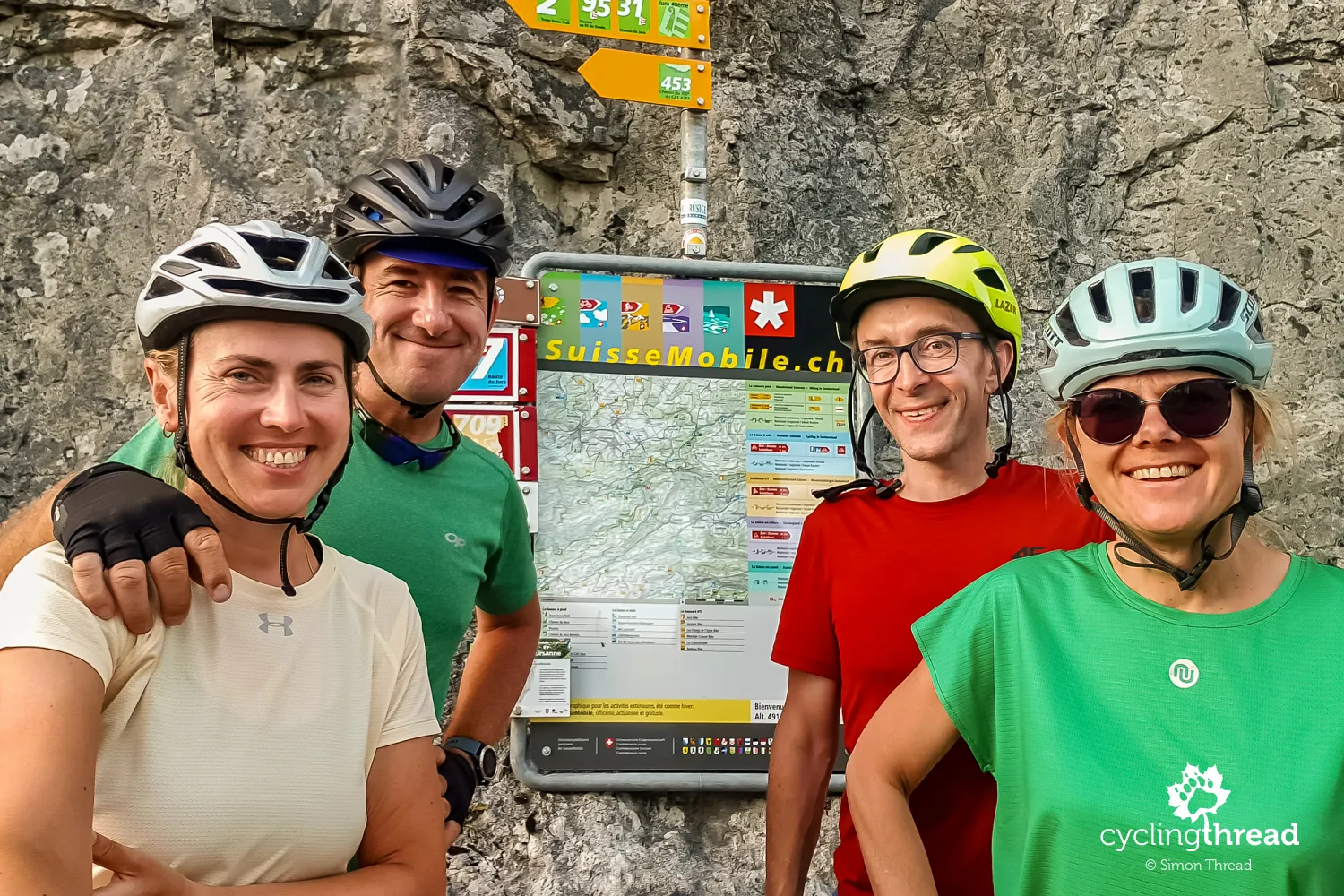
Quiet Jura divided by stone walls
The journey along the Jura Route starts with a dramatic shift in scenery. Leaving Nyon on the shores of Lake Geneva - with the Alps and Mont Blanc in the distance - we quickly entered Jura’s forests and began a steep climb. After several kilometers of uphill, some sections reaching over 10% gradient, we had gained nearly a kilometer in elevation and found ourselves in a completely new landscape, nothing like the busy shores of Lake Geneva. A narrow asphalt road led us through forest glades that opened into wide meadows, where limestone rocks of all sizes poked out from under the grass. These rocks had been used by local landowners to build the stone walls that mark the borders of pastures, where cows now peacefully graze.
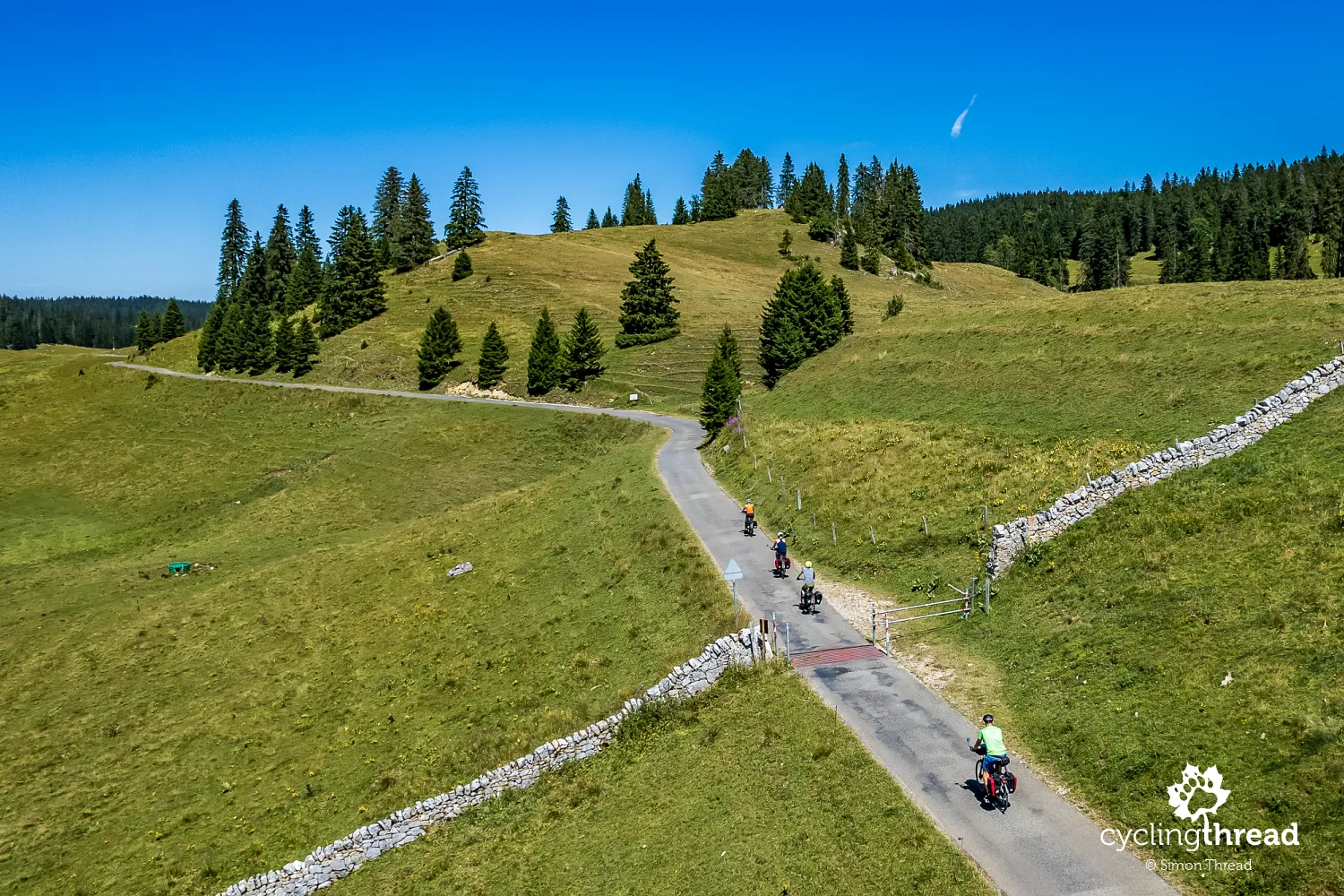
Two hundred and fifty million Jurassic ants
This unique area is part of the Jura Vaudois Nature Park - a regional nature park in Switzerland that aims for balanced social, ecological, and economic development, reconciling the need to protect Jura’s nature with the needs of local communities and businesses. One of the park’s most famous attractions is a supercolony of ants, reached via a nature trail on the Marchairuz Pass, which the Jura Route crosses. The colony is said to number around 250 million ants, working together as one massive community. Even the famous David Attenborough filmed a documentary about Jura’s ants! The park also includes the Vallée de Joux with Lac de Joux - the largest lake in the Swiss Jura - which you can see beautifully as you descend the long, fast ride down from the Marchairuz Pass.
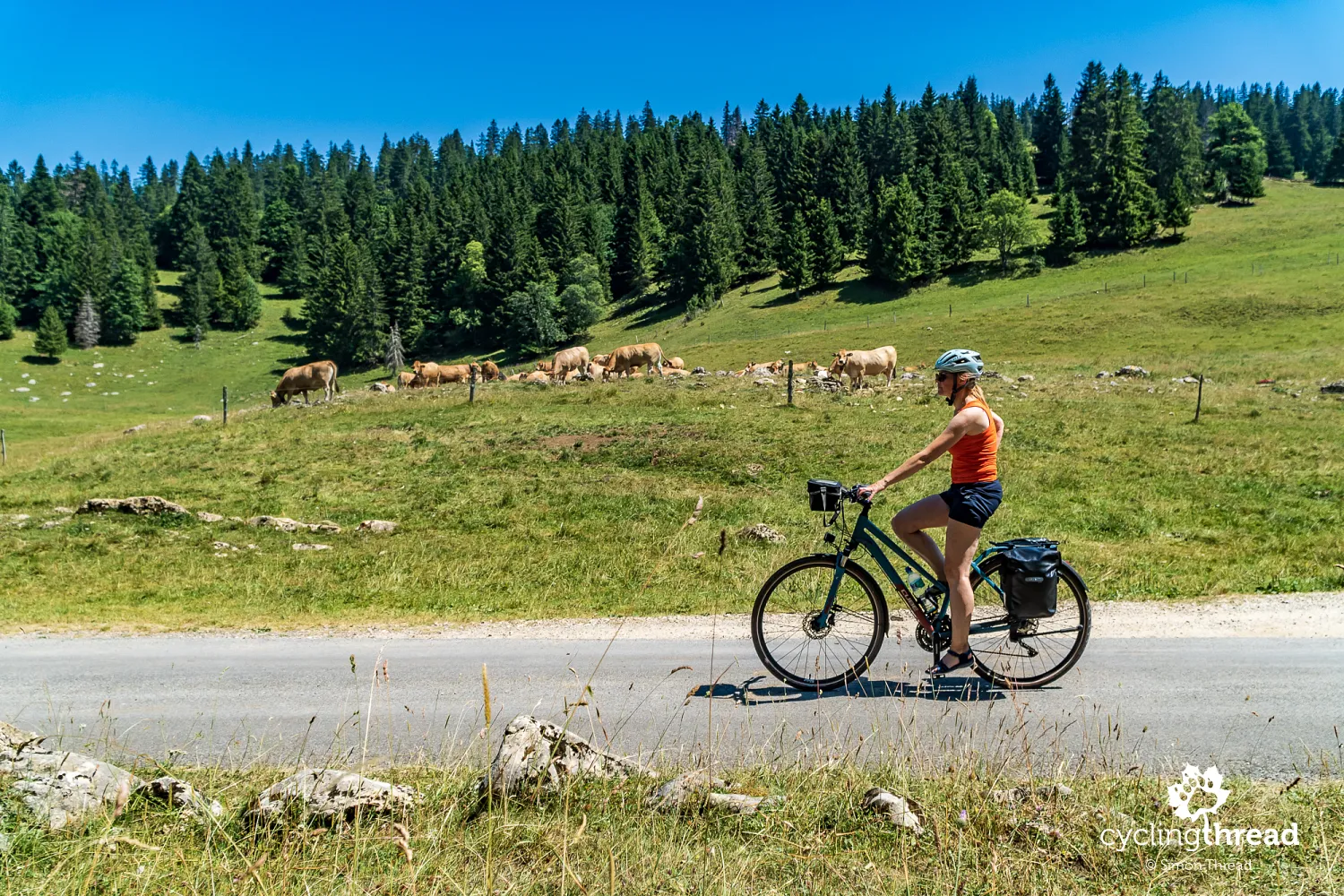
Jura, the cradle of Swiss watchmaking traditions
The small towns on the shores of Lac de Joux, nestled in the Vallée de Joux, are one of the birthplaces of Switzerland's most iconic tradition - watchmaking. In the former watch factory in Le Sentier, you’ll find the Espace Horloger watchmaking museum - the first of its kind in the canton of Vaud. The museum tells the story of how watchmaking skills were passed down from father to son over generations, which helped Jura earn its extraordinary reputation as the heart of the Swiss watchmaking industry. Surprisingly, this craftsmanship grew out of the farmers’ winter downtime, when, back in the 16th and 17th centuries, locals began producing simple mechanical components, eventually mastering the art of making sophisticated timepieces. One of the highlights of the museum in Le Sentier are the interactive tables, where you can step into the shoes of a Swiss watchmaker from centuries past and try assembling traditional watch mechanisms yourself.
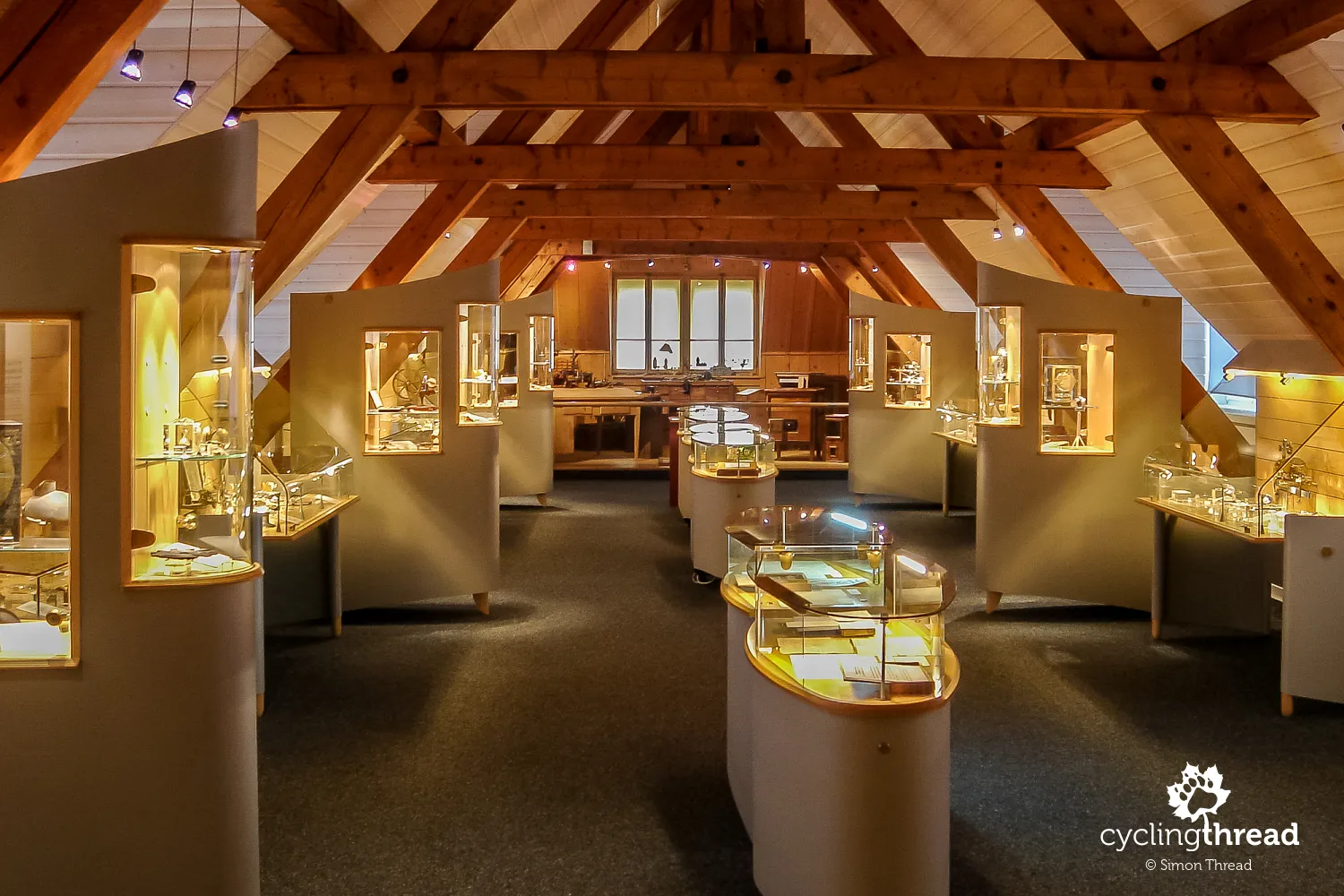
Not-so-safe Jura gravel roads
Cycling along Lac de Joux for a dozen or so kilometers gives a totally different feel to our journey. The route runs flat here, almost without any climbs, passing by a few beaches and swimming spots. But in these quiet Swiss towns, restaurants tend to close early - by 2 PM that day, leaving us without the lunch we had planned. After the last town - Les Charbonnières, tucked under the distinctive peak of Dent de Vaulion - we start climbing again, only to soon enjoy a long, fast, and somewhat winding descent to Vallorbe. At first, the gravel road looks so tempting that we let the brakes go, quickly reaching speeds over 30 km/h. But then, on one curve, loose gravel scattered across the road takes us by surprise, and both Marek and I hit the ground after our front wheels slide out. As a result of that reckless descent, Marek ended the day with a badly bruised wrist, and I continued riding the Alpe-Adria Route in Austria and Italy with a scraped knee. It could have been worse ;)
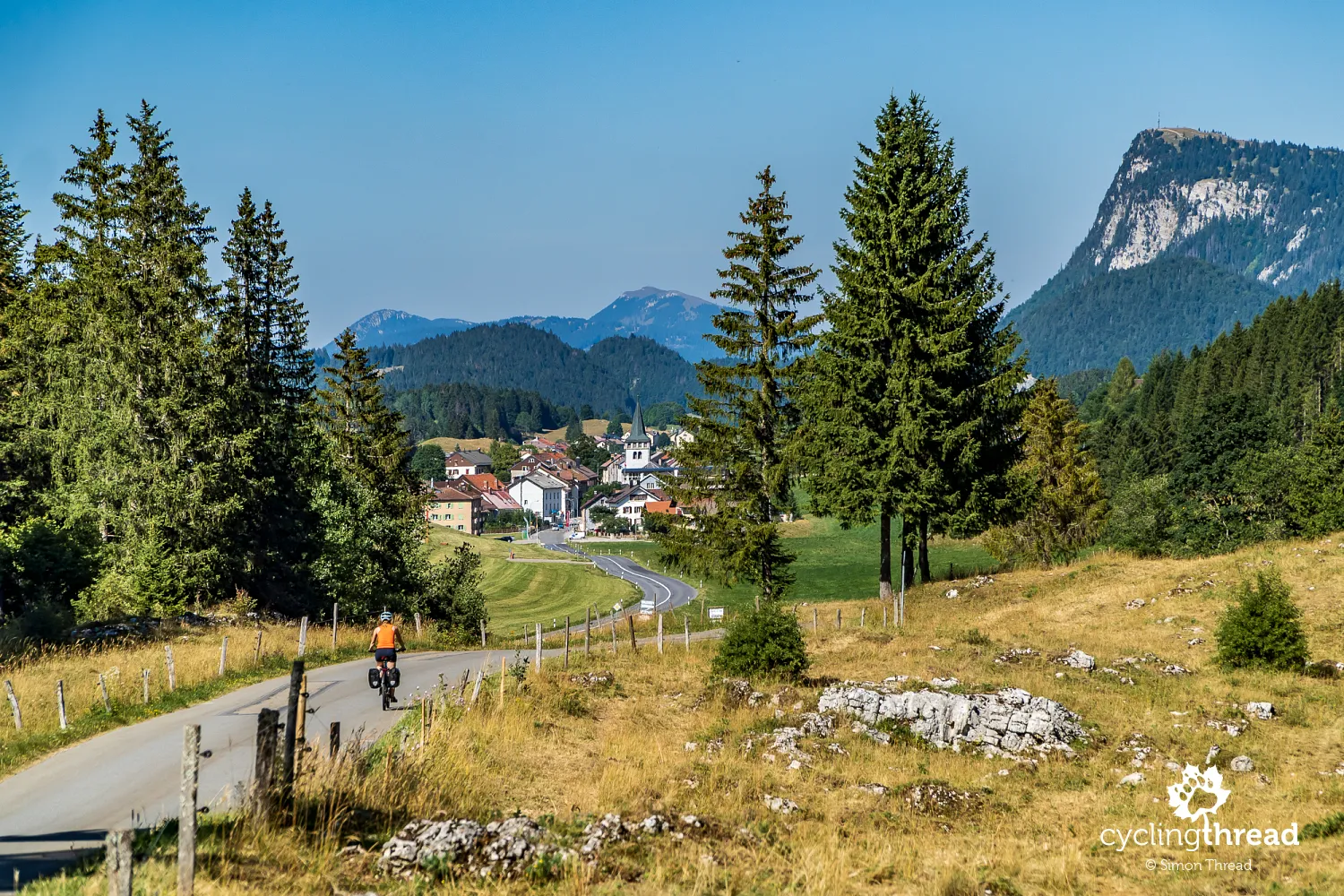
Potato rösti at a Swiss farmhouse stay
About 3 kilometers outside the city, you’ll find the famous Vallorbe caves, but since it was getting late, we had to skip them. For the night, we stayed in a cozy guesthouse in Lignerolle, set in an old building right in the center of the village. The place had the simple charm of a rustic countryside stay, much like a small family-run farm guesthouse. Even though we arrived late, the owner personally prepared dinner for us. Once again, we couldn’t resist ordering rösti - the Swiss potato dish we had enjoyed so much along the Lakes Route. This time, the rösti was served with a delicious mushroom sauce and beer from a nearby brewery on Lake Geneva. The friendly host kept us company through most of dinner, chatting about what awaited us the next day - another steep climb from Baulmes up to Jura’s main ridge.
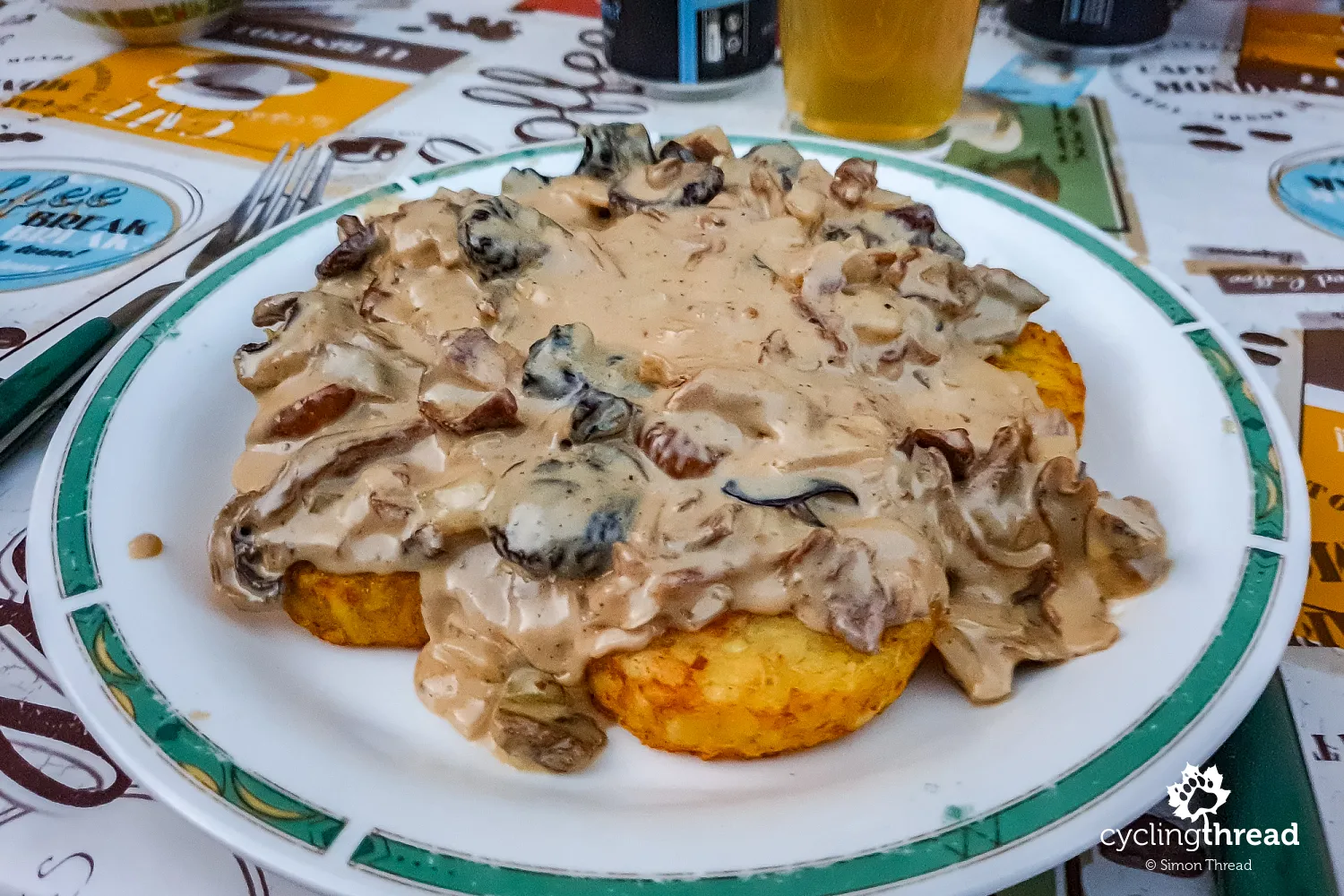
Our host was right - as soon as we reached Baulmes, a roughly 7-kilometer climb began, more than half of which included steep stretches over 10%, making us break quite a sweat. Thankfully, the effort was rewarded with stunning views, reminding me of the Polish-Czech borderlands in the Izera Mountains. Below us sparkled Lake Neuchâtel, and on the horizon, beyond a thin mist, we could see the Bernese Alps - another reminder of the Lakes Route we had just completed, cycling from Zurich to Geneva via Interlaken. As we climbed toward Col de l'Aiguillon Pass, we were treated to beautiful, dramatic scenery. At one point, towering rock cliffs, several dozen meters high, loomed above us - one of the few such impressive formations along our route - marking the peak of Aiguilles de Baulmes.
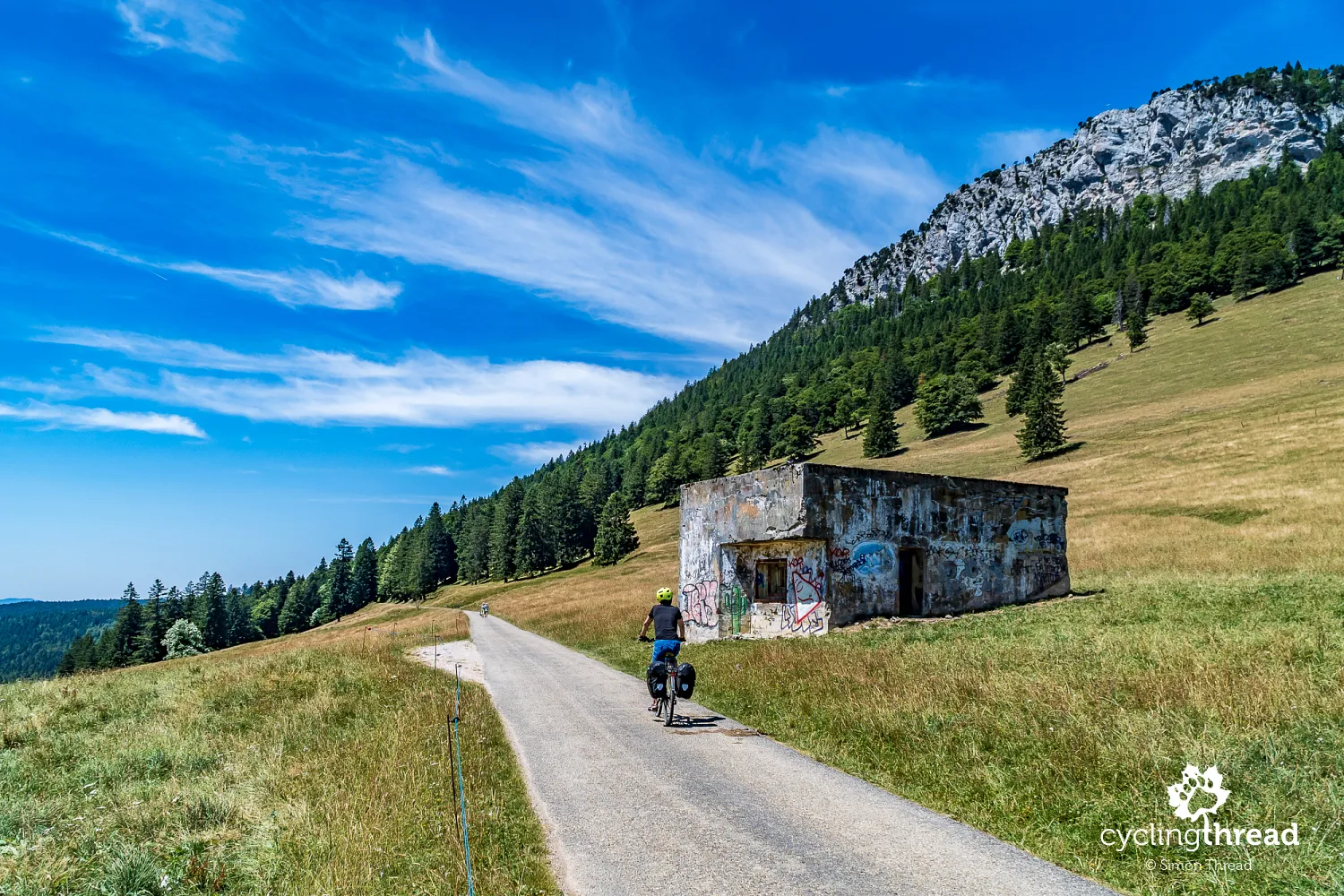
The homeland of Swiss absinthe - the “green fairy”
That day, we reached the Travers Valley and the town of Môtiers, known as Switzerland’s most famous center for absinthe production - the so-called "green fairy," a spirit made from wormwood, anise, fennel, and other herbs. The tradition of absinthe in Val-de-Travers is presented at the Absinthe House, located in a former courthouse where, for many years, the ban on absinthe production was enforced. First introduced in 1910, the ban wasn’t lifted until 2005, so legal production and tasting rooms are still a relatively new - and growing - part of the local economy. Interestingly, Swiss absinthe is often unavailable for online purchase, which makes Jura an even more special place to visit. In nearby Boveresse, it’s worth checking out a historic wooden absinthe drying shed, still in use today, located less than a kilometer off the route.
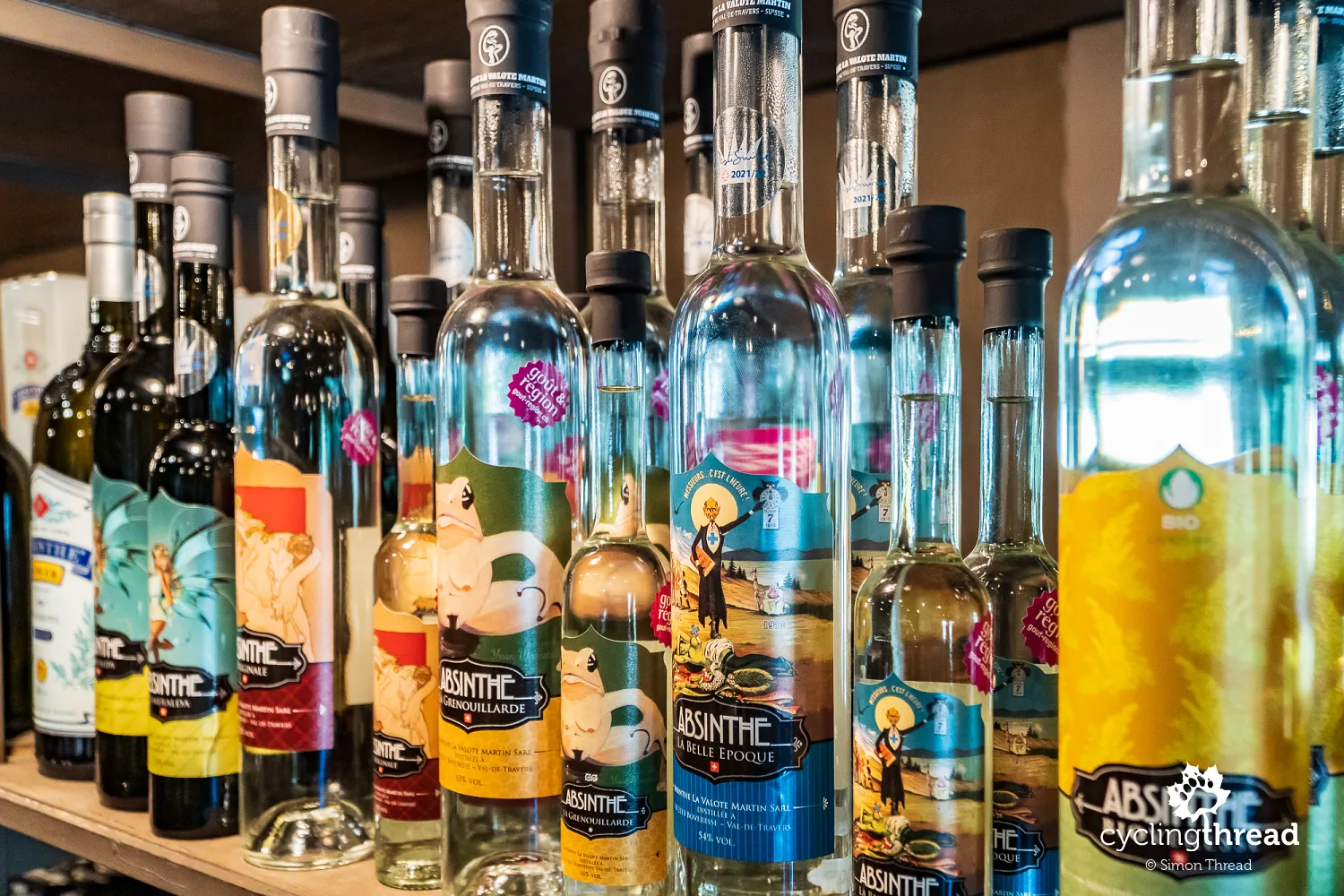
Or maybe ham cooked in hot asphalt?
About 5 kilometers farther, just a few hundred meters off the route, lies the old La Presta asphalt mine, now home to a museum exhibition dedicated to the history of extracting this rare natural material. Natural asphalt was mined in Jura for over three centuries - and just a few dozen meters from the restored mine buildings, you can still enter underground tunnels on a guided tour. From the early 18th century until 1986, about two million tons of this "black gold" were extracted here. In the mine's café, you can try a local specialty - ham baked in hot asphalt, said to be a traditional treat prepared by miners for Saint Barbara’s Day, their patron saint. You can also sample or buy a bottle of absinthe - making for a very Jura-style culinary experience!
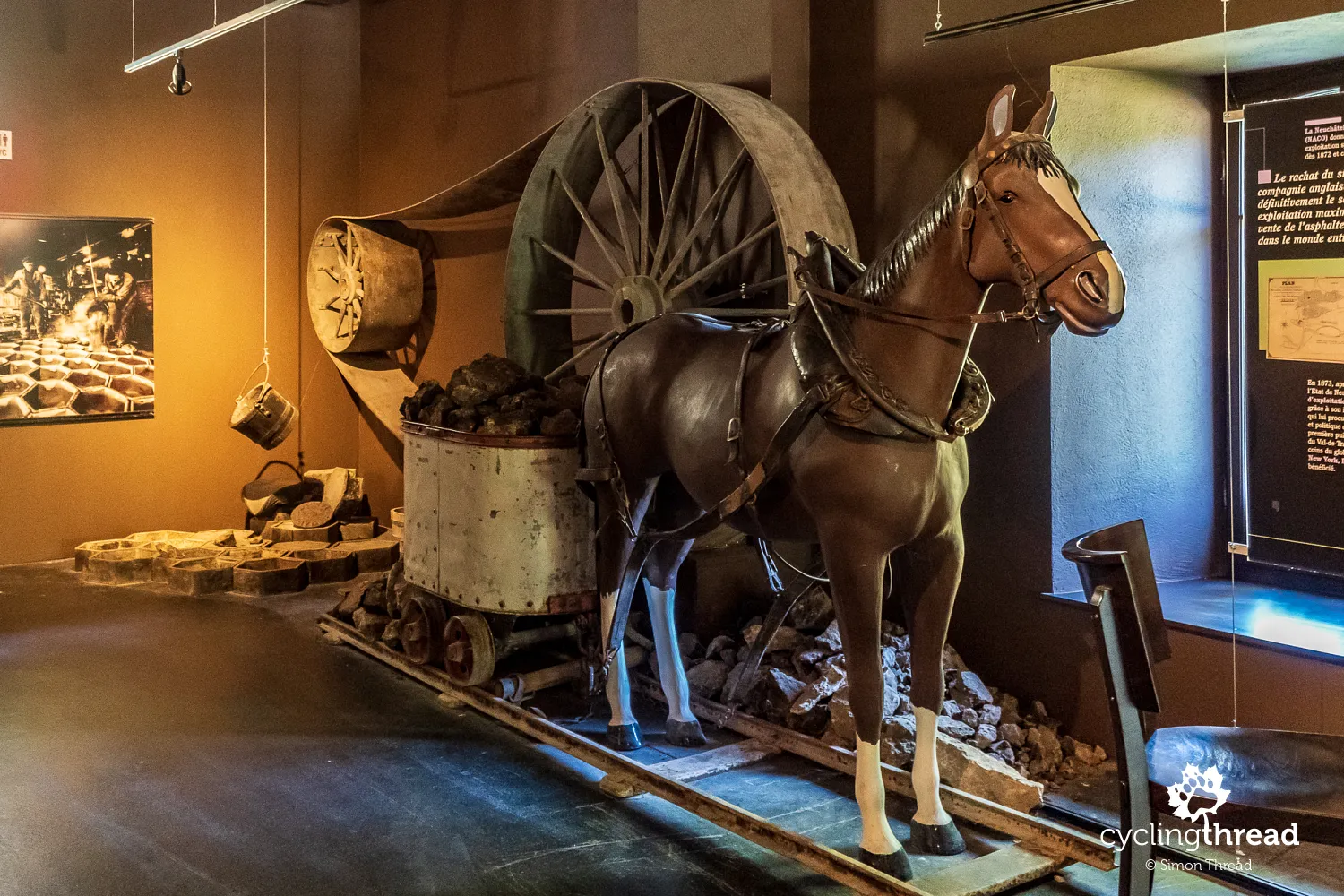
Jura in Switzerland, unlike the Jura in Germany
Day three, and… yet another tough Jura climb to kick off the day. This time, it’s around 4 kilometers of steady uphill pedaling, with more than half of it featuring gradients over 10 percent. Adding to the challenge was the heat and lack of water on the route - a warning we had read in one of the guidebooks. All this makes me say that cycling the Jura Route is much tougher than the Lakes Route - which I keep comparing it to. Before the trip, I actually thought that the Jura Route would be somewhat like the Tauber-Altmühl Radweg in Franconia, and I was also curious how it might compare to the Eagle Nests Route, one of the cycle routes in Poland. But it turned out that the Jura in Switzerland is a true mountain range, and if you’re planning to cycle here, think of it as a mountain adventure, not just a countryside ride. The climbs - both in length and gradient - are incomparably longer and tougher than in similar Jura regions in Germany or Poland.
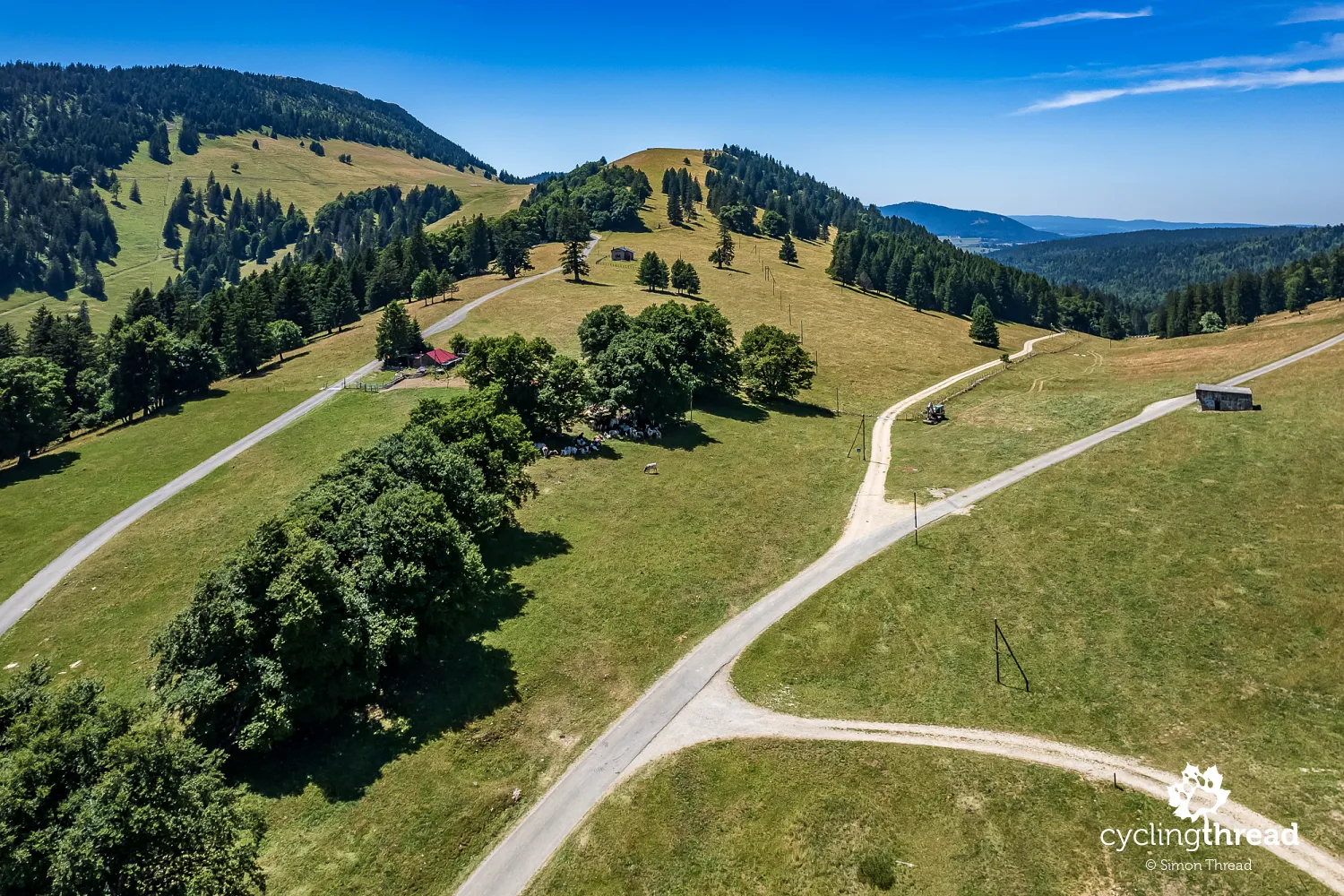
With Extrawheel panniers across Europe
The Jura Route was another trip where we returned to using panniers from Polish brand Extrawheel. Along with the classic Wayfarer side panniers, my bike was also equipped with Extrawheel’s latest addition - the brand-new Handy XL handlebar bag. This is a practical, durable, made-in-Poland bag, similar in size and design (7.5 liters) to Ortlieb’s well-known handlebar bags. What makes it different is its stiffer construction and a snap-closure system instead of magnets. After many days on the road, I can say the mounting system is solid, stable, and fully compatible with Ortlieb mounts, thanks to KlickFix. The bag is made from original Cordura, which makes it resistant to damage and weather. Honestly, I can’t imagine riding without quick access to all the essentials - wallet, power bank, memory cards, headlamp, headphones, and a dozen other small things, not to mention a selfie stick!
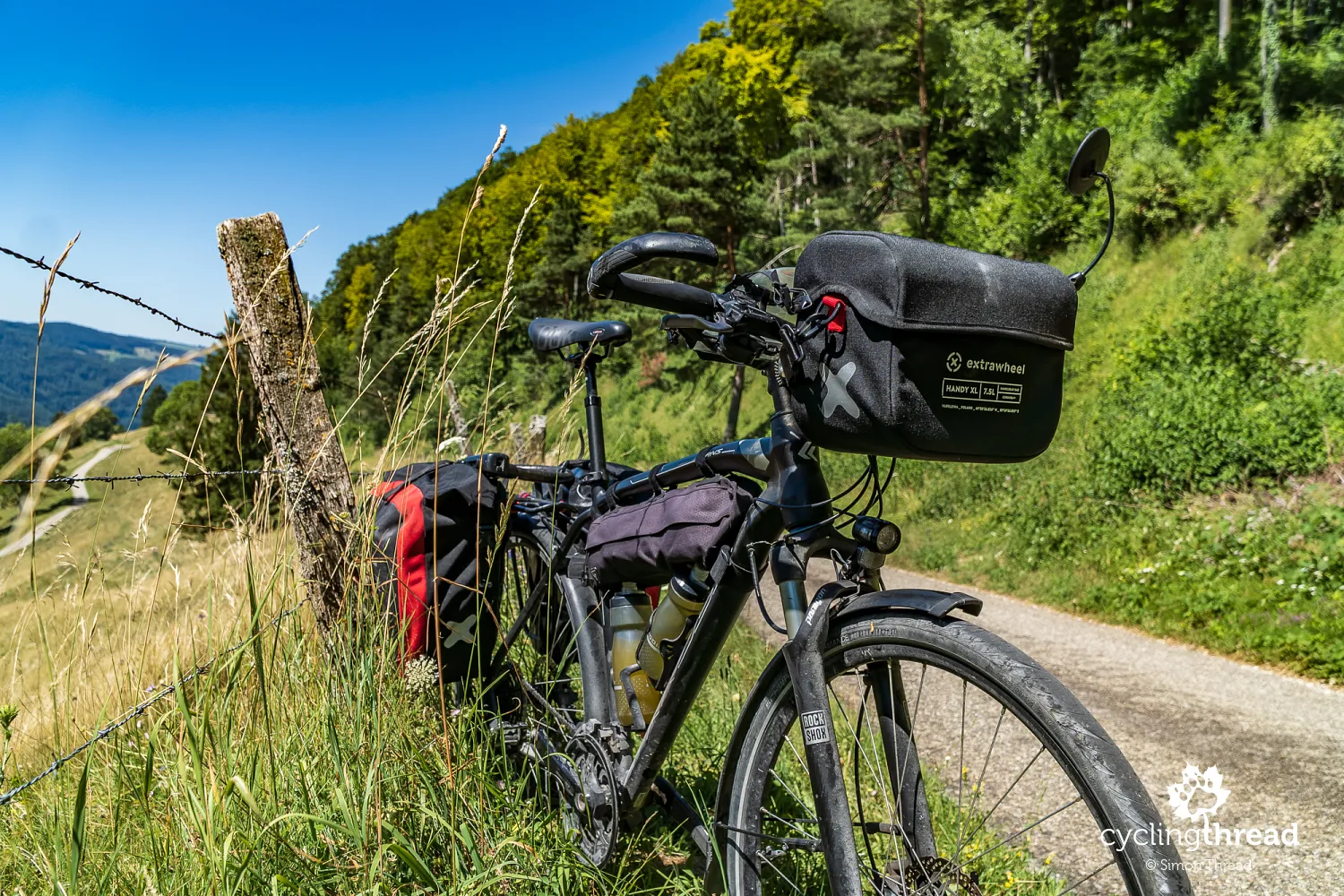
Art Nouveau, watches, and Islam in La Chaux-de-Fonds
From a sleepy and rather uneventful stretch of the Jura Route near Les Ponts-de-Martel, we suddenly rolled into La Chaux-de-Fonds, a city of almost 40,000 people. Sitting at about 1,000 meters above sea level, it’s one of the highest cities in Europe. Immediately, we were surrounded by a vibe of French Art Nouveau from the early 19th century, with tall, decorative townhouses dominating the historic city layout. The city was completely rebuilt in a very organized, functional way after a great fire in the early 1800s - designed to provide ideal living and working conditions for a booming watchmaking center. Even Karl Marx wrote about it in "Das Kapital", and in 2009 La Chaux-de-Fonds, along with neighboring Le Locle, was added to the UNESCO World Heritage List. Today, it’s the third-largest city in French-speaking Switzerland, after Geneva and Lausanne.
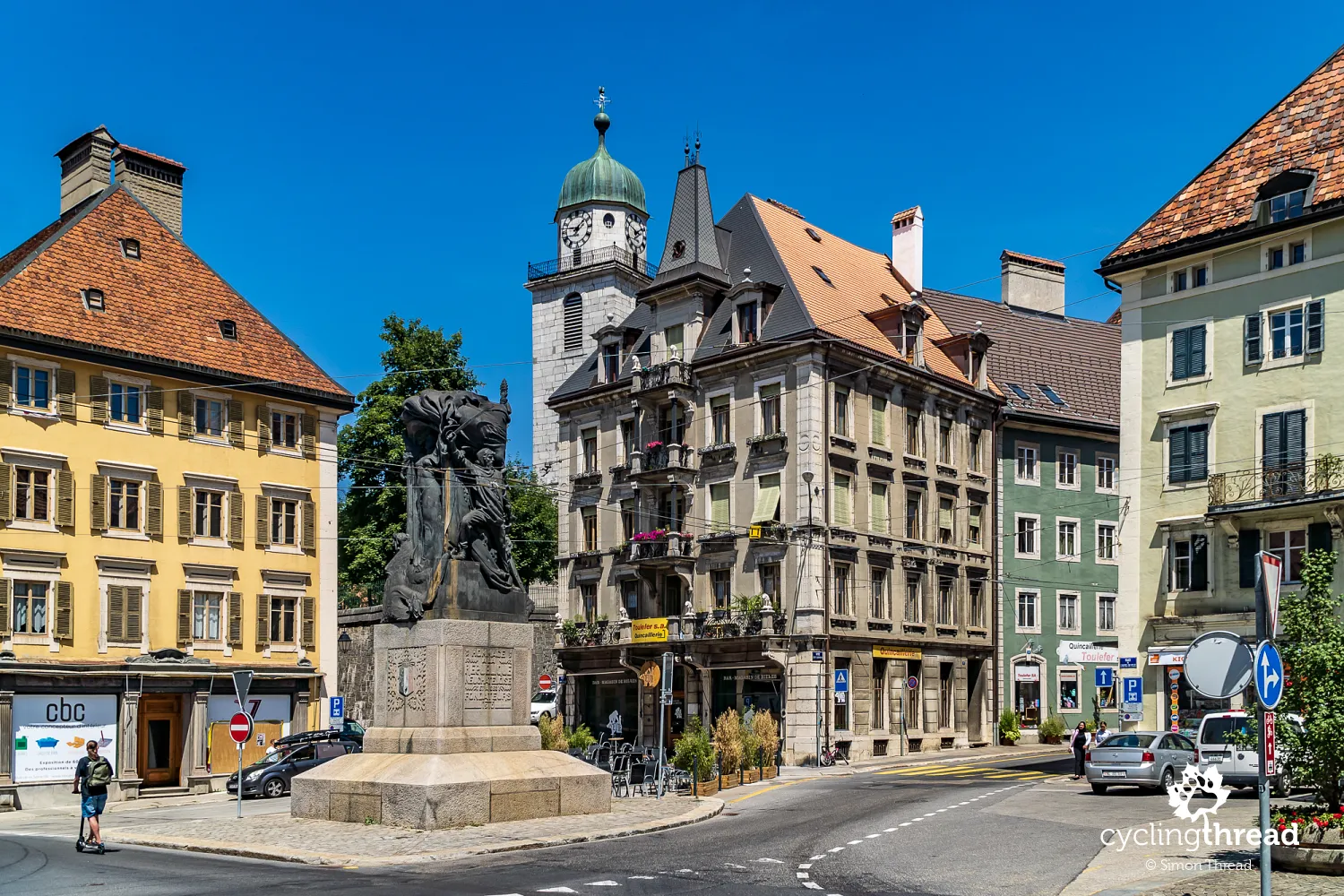
If you’re following our route, make sure to spend more time in La Chaux-de-Fonds - rushing through it like any other town on the way would be a huge mistake. It’s definitely the most fascinating city on this journey. Its top attraction is the International Watchmaking Museum, showcasing the history of this unique craft and featuring clocks and watches from all over the world - a collection of 4,500 pieces! Founded in 1902 - over 120 years ago - the museum moved into its current, purpose-built, slightly avant-garde building in 1972. La Chaux-de-Fonds is also the birthplace of famous figures like architect Le Corbusier and Louis Chevrolet, founder of the American car brand. And if we had a bit more time, we would have loved to visit the rather unusual Museum of Islamic Civilizations located here.
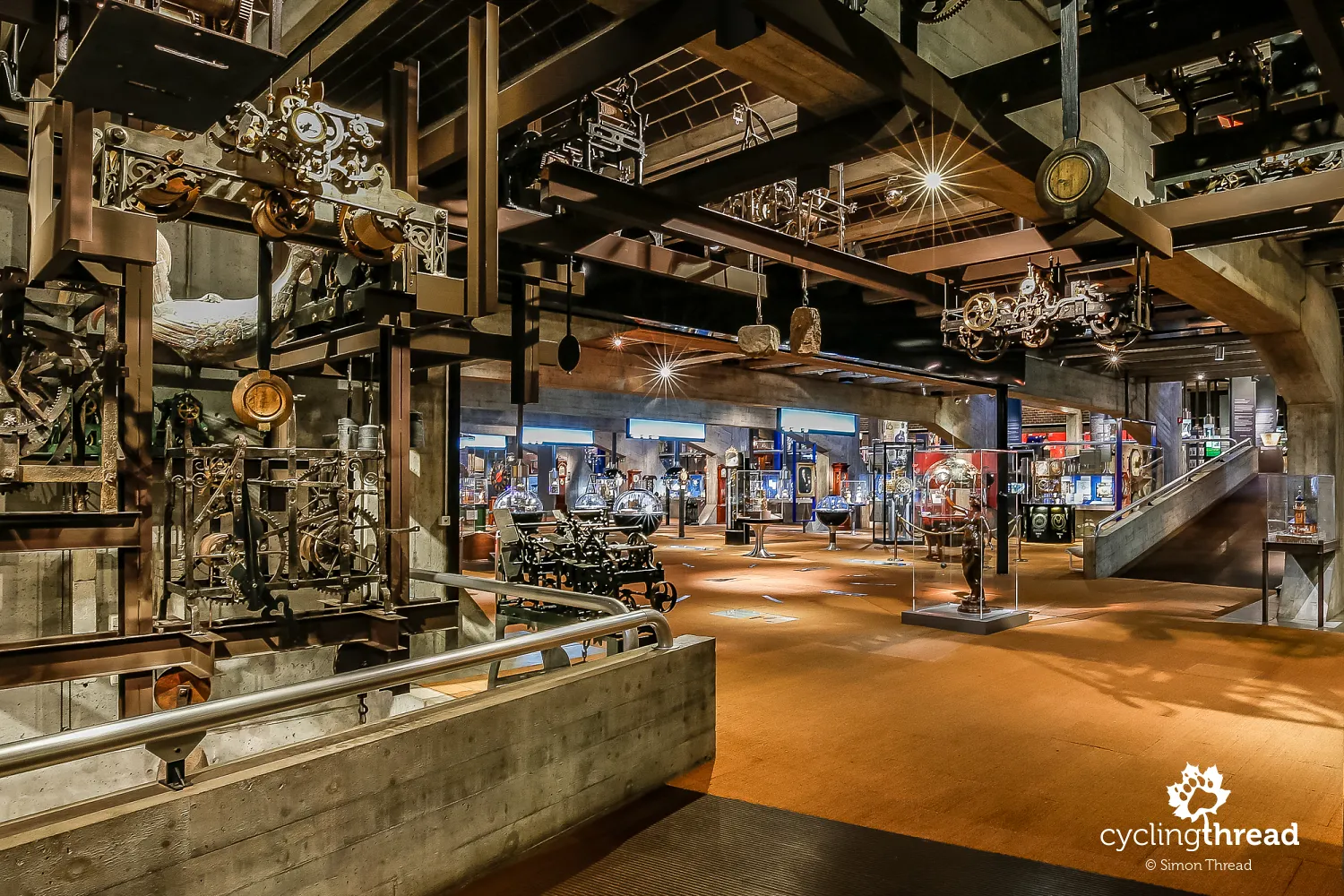
Across the Franches-Montagnes plateau to Saint-Ursanne
For the next stretch of the Jura Route, we rode across the Franches-Montagnes plateau - home to the Swiss horse breed of the same name. With a bit of luck, you can spot them grazing near the many farms along the route. Proud owners often display plaques and awards from agricultural shows and competitions. This area is also popular with hikers and cyclists, and one of its biggest attractions is the small lake Etang de la Gruère, surrounded by forest and located just a few hundred meters from the cycling route. We ended the day in beautiful Saint-Ursanne - a medieval town perched on the Doubs River, often called the “pearl of Jura.”
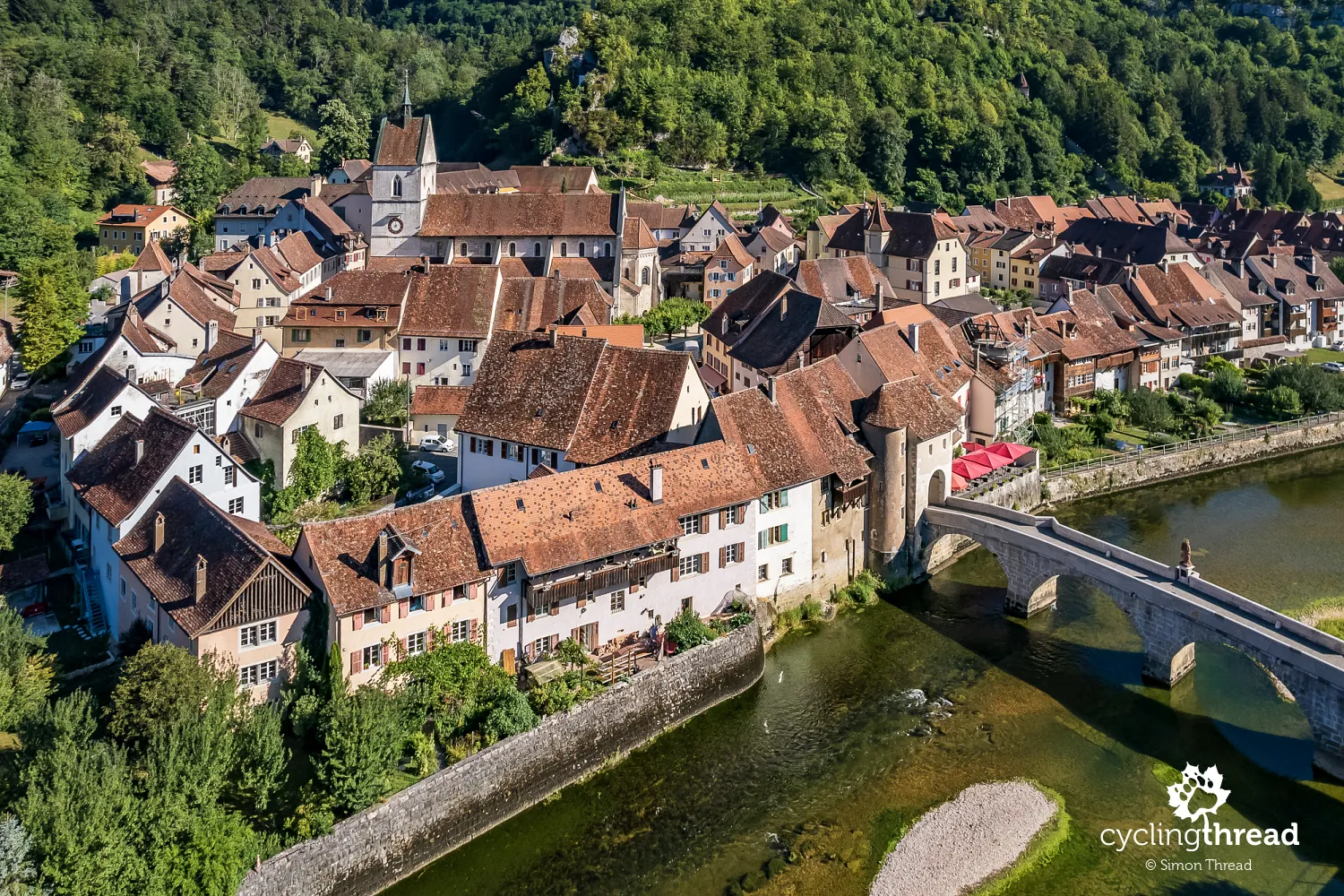
Saint-Ursanne is among the most beautiful towns in Switzerland and one of the three best-preserved historic towns in Jura, alongside the larger towns of Delémont and Porrentruy. The town grew in the 13th and 14th centuries around an ancient monastery, founded after the death of Irish monk Ursicinus in the 7th century. Its main attraction is the Romanesque collegiate church, built between the 12th and 14th centuries. Together with surrounding townhouses and three city gates, it creates a perfect setting for a morning walk - something we couldn’t resist before heading out on our final day cycling Jura. Before leaving, we made sure to take a classic souvenir photo on the bridge featuring the statue of Saint John of Nepomuk.
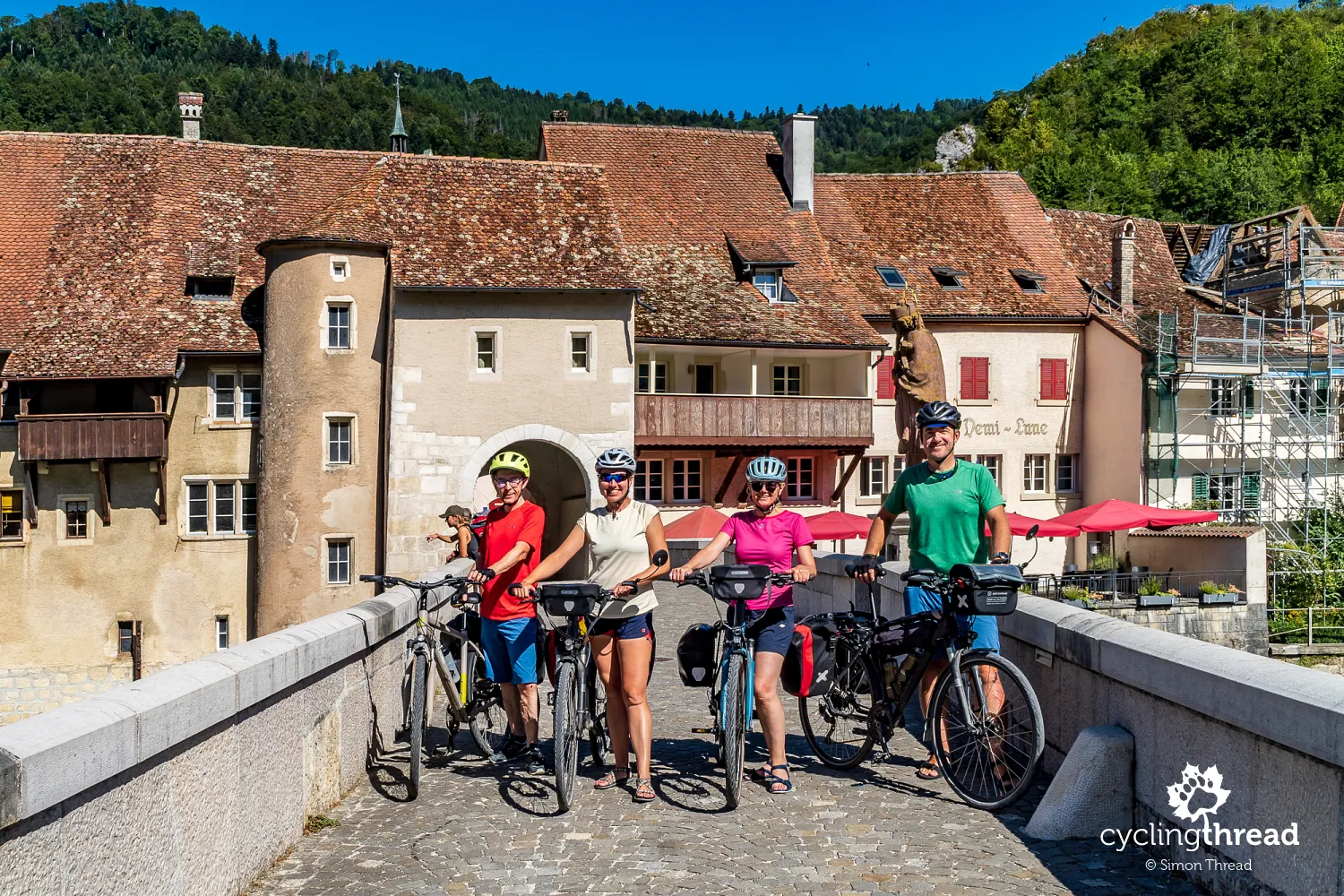
In the heart of Switzerland's separatist canton of Jura
While cycling through Jura and exploring Saint-Ursanne, it’s worth remembering that you are in the very center of the canton of Jura - Switzerland’s youngest canton. Jura was created in 1979, more than 150 years after the Congress of Vienna had attached these French-speaking lands to the German-speaking canton of Bern. Ever since then, the French-speaking Catholic and Protestant minority had been striving to highlight their distinct identity and separate from the German-speaking Protestant majority. It was only after three referendums held between 1974 and 1975 - known as cascading referendums due to their complexity - that part of the population achieved their goal. The first vote showed that the majority of Jura’s residents supported breaking away from Bern and forming a new canton, which led to the second vote. That one identified the districts willing to join the new canton, and the third referendum finally defined the exact areas that would become the canton of Jura. The peaceful way this process unfolded is today considered a great example of Switzerland’s advanced civil society. And national referendums remain a common way of deciding important matters in Switzerland to this day.
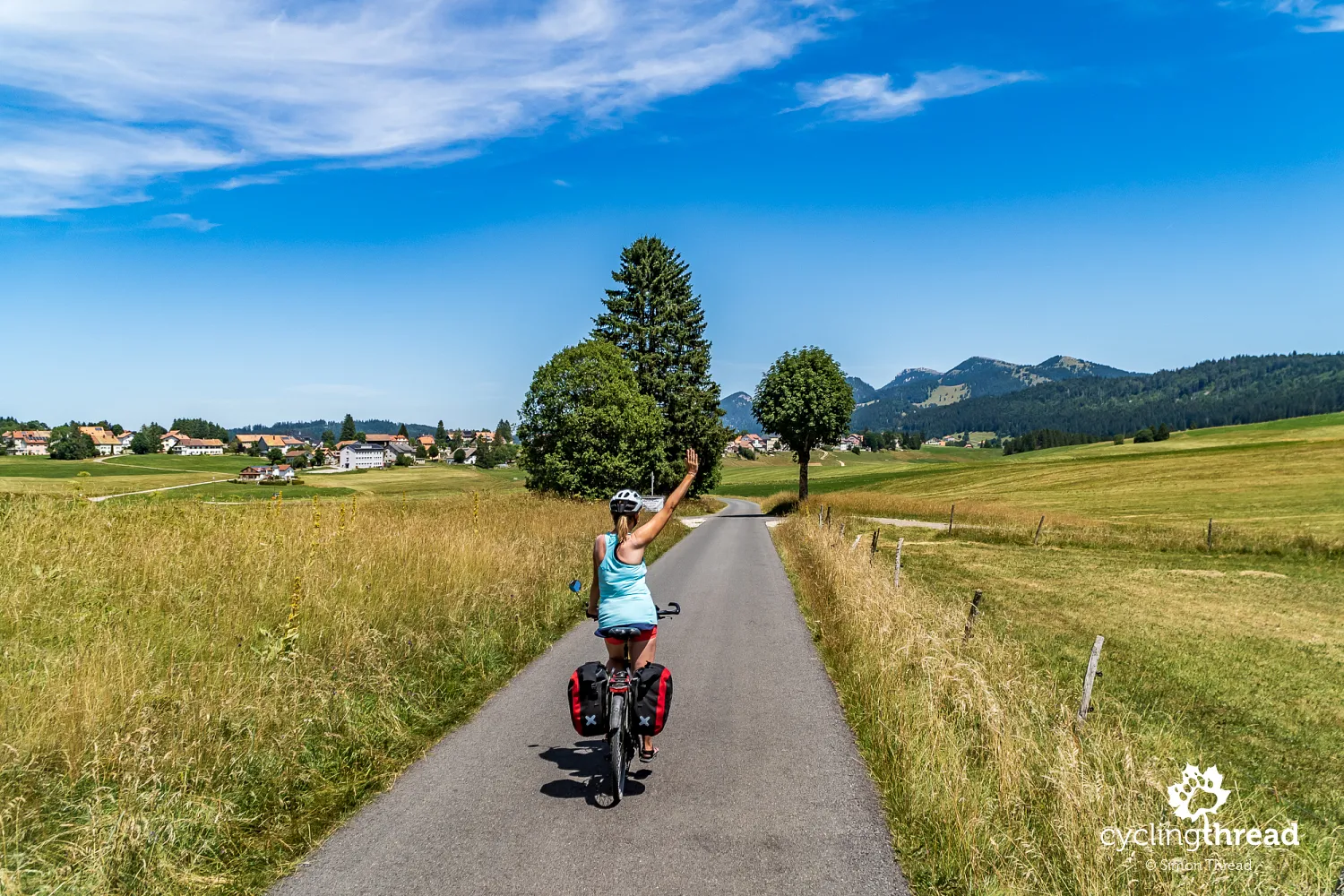
On the route of the Grand Tour of Switzerland
It’s through places like Saint-Ursanne and the surrounding areas that the Grand Tour of Switzerland passes - a scenic route originally designed for motorists but also a fantastic way for cyclists to discover the best of Switzerland. Two segments of the Grand Tour, labeled F and G, run through western Switzerland, including Jura. Segment F starts by Lake Geneva and leads through Nyon, the Vallée de Joux, the Val-de-Travers with Môtiers, and up to Jura’s iconic landmark - the massive glacial cirque Creux du Van, though it lies off the Jura cycling route. Segment G closely follows parts of the Jura Route itself - beginning in Basel, passing through Delémont, Saint-Ursanne, Lake Etang de la Gruère, Bellelay Abbey, and finally La Chaux-de-Fonds. More details can be found in the free PDF guide available on www.myswitzerland.com.
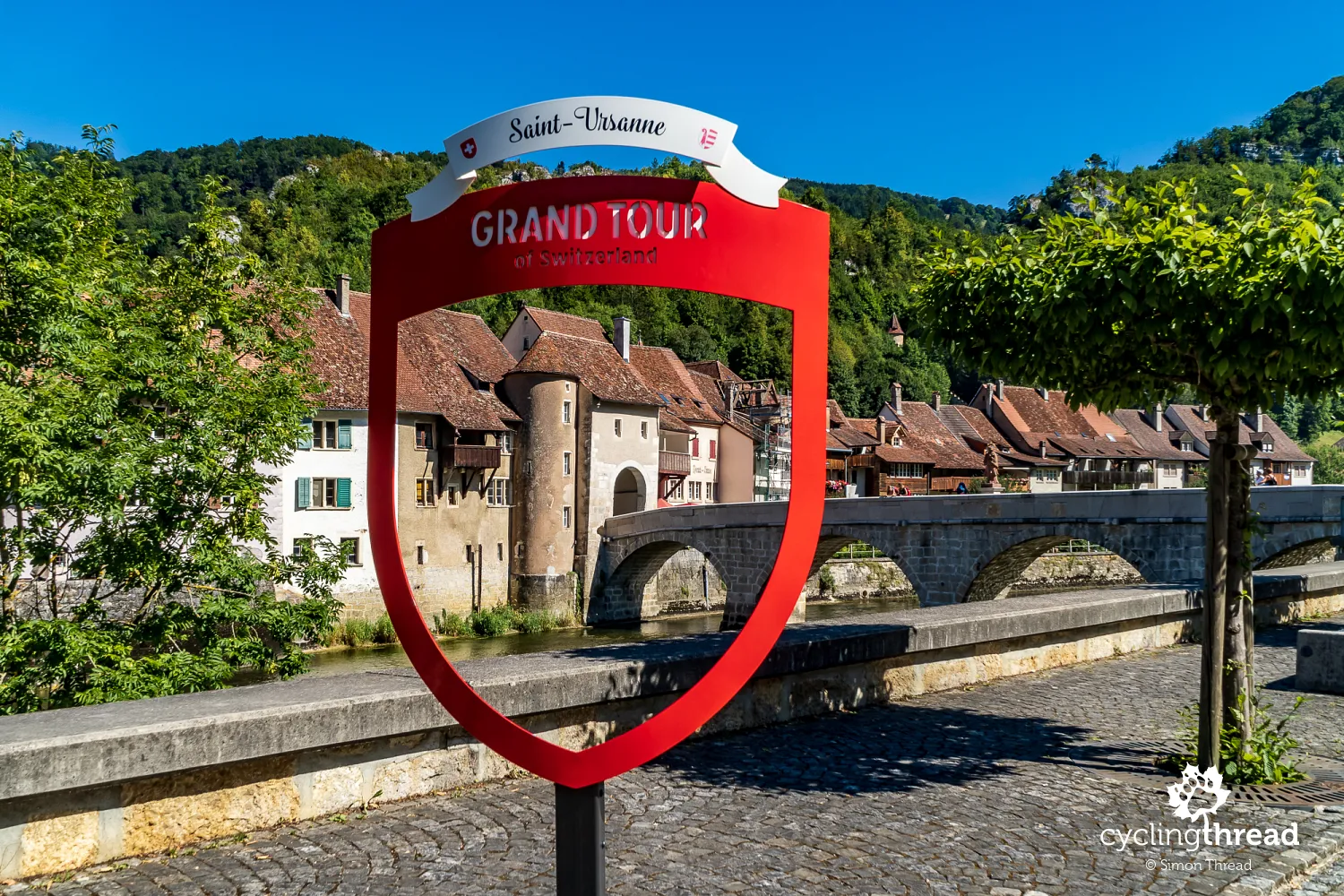
The final forty kilometers to Basel
Our last day, naturally, began with - you guessed it - another challenging climb. This time we set off towards the Col de la Croix, following a route used annually for one of the European Hill Climb Championships car races. But this was one of our final mountain sections in Jura. By midday, road signs were already signaling that we were approaching the end of our journey - Basel. After the village of Lucelle, we enjoyed a long, peaceful 15-kilometer descent along the river of the same name, which snakes along the French-Swiss border, crossing between countries several times. A final short climb took us past the Mariastein Abbey before rolling towards Basel, where we had ended our Rhine Cycle Route journey two years earlier.
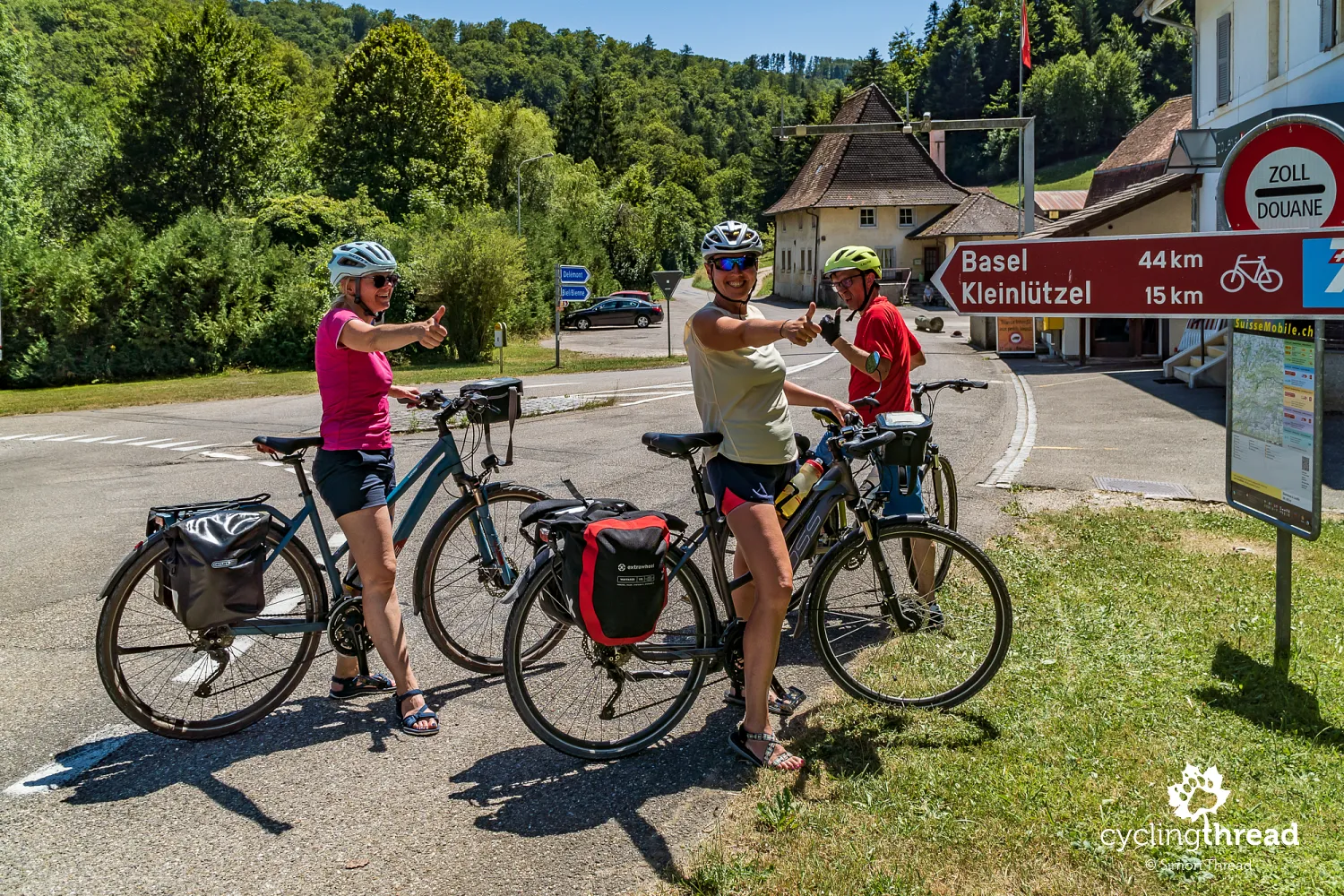
Who is the Jura Route for?
The Jura Route was definitely one of the hardest mountain cycling routes we’ve ridden. Although many sections run across gentle, peaceful plateaus, each of them is separated by valleys where we would drop down for an overnight stay - only to face another steep climb the next day to get back up into the mountains. Gradients of over ten percent are much tougher than the average hill on a typical cycling trip - something to keep in mind when planning your ride. Can you bring kids? Yes, but probably only older, more independent children who are aware that a significant part of the route runs on public roads, including quiet but real country highways. Still, the Jura Route in Switzerland is mostly for those who value peace, quiet, and natural, rural landscapes over busy cities and showy tourist attractions.
Back to top


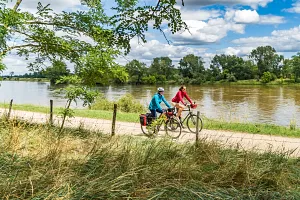
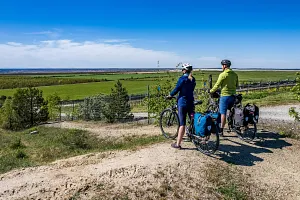
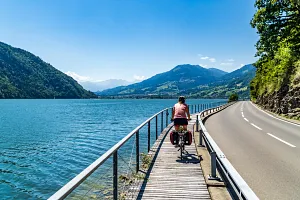
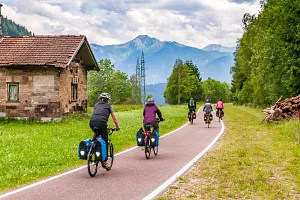
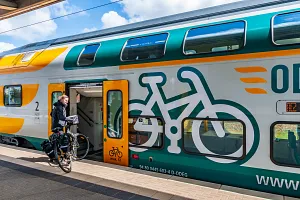
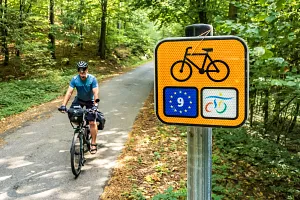
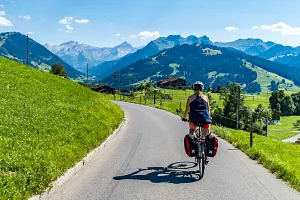
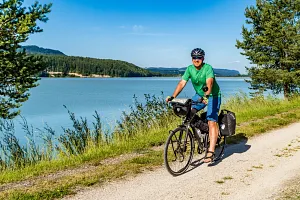
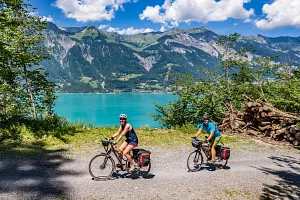
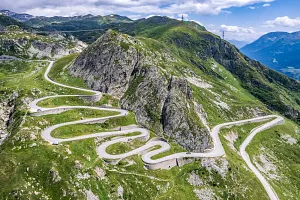
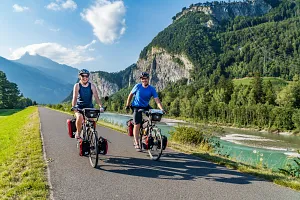
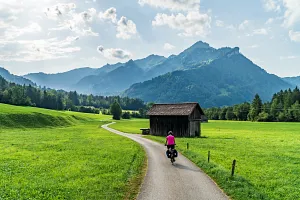
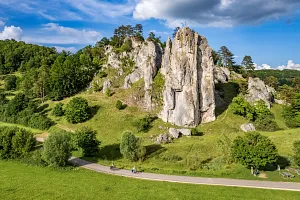
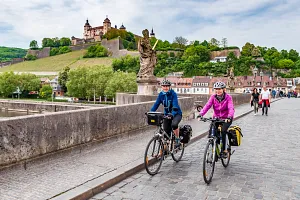
Your Comments
Add new comment